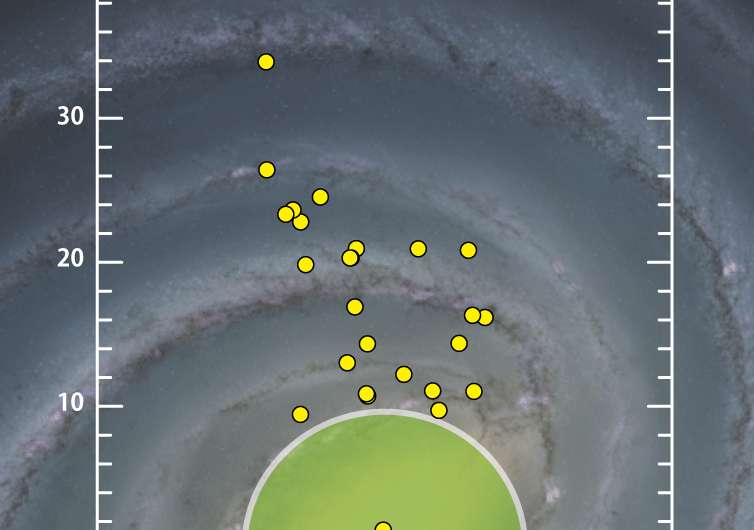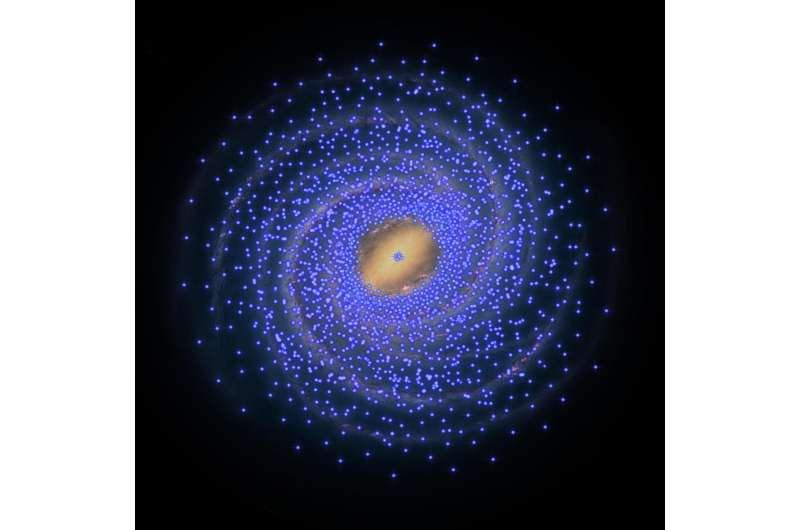A giant stellar void in the Milky Way

A major revision is required in our understanding of our Milky Way Galaxy according to an international team led by Prof Noriyuki Matsunaga of the University of Tokyo. The Japanese, South African and Italian astronomers find that there is a huge region around the centre of our own Galaxy, which is devoid of young stars. The team publish their work in a paper in Monthly Notices of the Royal Astronomical Society.
The Milky Way is a spiral galaxy containing many billions of stars with our Sun about 26,000 light years from its centre. Measuring the distribution of these stars is crucial to our understanding of how our Galaxy formed and evolved. Pulsating stars called Cepheids are ideal for this. They are much younger (between 10 and 300 million years old) than our Sun (4.6 billion years old) and they pulsate in brightness in a regular cycle. The length of this cycle is related to the luminosity of the Cepheid, so if astronomers monitor them they can establish how bright the star really is, compare it with what we see from Earth, and work out its distance.
Despite this, finding Cepheids in the inner Milky Way is difficult, as the Galaxy is full of interstellar dust which blocks out light and hides many stars from view. Matsunaga's team compensated for this, with an analysis of near-infrared observations made with a Japanese-South African telescope located at Sutherland, South Africa. To their surprise they found hardly any Cepheids in a huge region stretching for thousands of light years from the core of the Galaxy.
Noriyuki Matsunaga explains: "We already found some while ago that there are Cepheids in the central heart of our Milky Way (in a region about 150 light years in radius). Now we find that outside this there is a huge Cepheid desert extending out to 8000 light years from the centre."

This suggests that a large part of our Galaxy, called the Extreme Inner Disk, has no young stars. Co-author Michael Feast notes: "Our conclusions are contrary to other recent work, but in line with the work of radio astronomers who see no new stars being born in this desert."
Another author, Giuseppe Bono, points out: "The current results indicate that there has been no significant star formation in this large region over hundreds of millions years. The movement and the chemical composition of the new Cepheids are helping us to better understand the formation and evolution of the Milky Way."
Cepheids have more typically been used to measure the distances of objects in the distant Universe, and the new work is an example instead of the same technique revealing the structure of our own Milky Way.
More information: Noriyuki Matsunaga et al. A lack of classical Cepheids in the inner part of the Galactic disk, Monthly Notices of the Royal Astronomical Society (2016). DOI: 10.1093/mnras/stw1548 , arxiv.org/abs/1606.07943
Journal information: Monthly Notices of the Royal Astronomical Society
Provided by Royal Astronomical Society





















